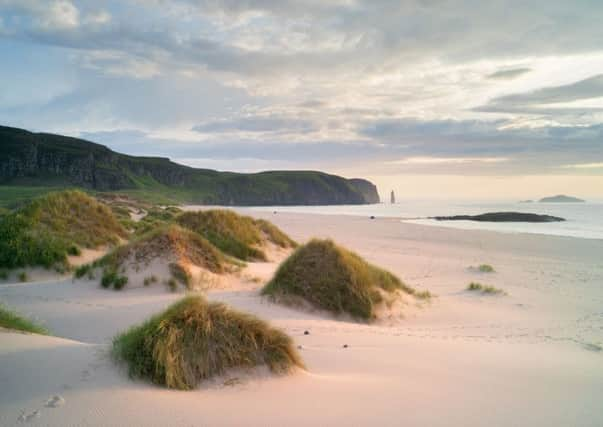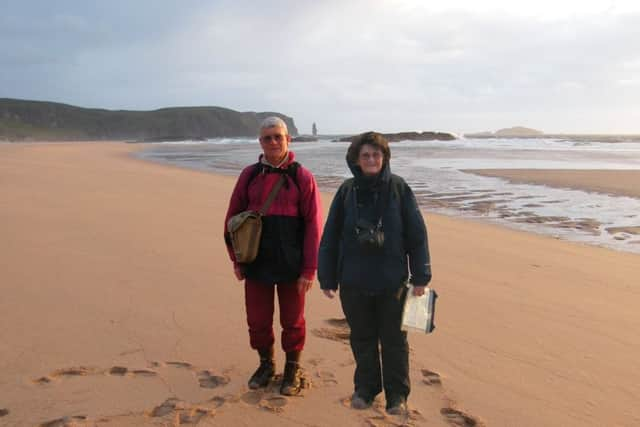An extract from To Oldly Go: Tales of Intrepid Travel by the Over-60s


PEOPLE have died out here,” he said darkly. This statement only increased our determination to carry on. “Hadn’t you better give this up? You haven’t reached the lighthouse yet, and then you’ll have to turn into the teeth of the wind.” But it had stopped raining an hour ago, the wind had lessened, the sky was brighter and the forecast was for it to improve throughout the afternoon and evening.
This was the fourth attempt by the minibus driver to make us give in and pay him to transport us back to civilisation. We didn’t want to go back to civilisation, we wanted to go on to civilisation – our car, parked four miles beyond Sandwood Bay with flasks of tea and chocolate biscuits in the boot. We would have liked to believe that he was really concerned for our safety but we couldn’t forget the look of annoyance on his face earlier that morning on the ferry when he was collecting fares for his minibus and we announced that we didn’t need his services because we intended to walk to Cape Wrath lighthouse, then out via Sandwood Bay.
Advertisement
Hide AdAdvertisement
Hide AdWe were already two-thirds of the way to the lighthouse on the track which snaked away across the hills ahead. It was bleak. Wild. Windy. We were completely on our own – except when the minibuses passed us every half hour.


Colin and I may have been in our dotage (well, sixties actually) but we had planned this hike in minute detail. It was part of our retirement project, to walk the entire coast of mainland Britain. We had started in Bognor Regis 11 years before when we turned left at the pier and continued walking. We may have had many breaks in time during which we had returned to the comforts of home, but we hadn’t had any breaks in the route. So far we had walked every inch of the way and we weren’t going to give up now because a minibus driver was vexed.
“Do you think you ought to continue?” he persisted. “You’re very slow, you’ve been walking four hours and you’ve only done eight miles.” So? That is our pace – two miles an hour including stops. Everything is going to plan.
Again we assured our apparently concerned friend that we were aware of the challenges we faced, that we had maps and compasses and knew how to use them, that we knew where the bothies were and would shelter in them if the weather turned nasty, that we had extra food and water in our rucksacks, and that we had informed two quite separate people of what we were doing so that if we didn’t turn up tomorrow they would send out search parties.
It was a few more miles to the lighthouse, the halfway point, and it didn’t seem to take us long. But that was the easy part – the second half would be much more challenging.
An open doorway announced The Ozone, the new café. It had recently been opened by Princess Anne, we later learned, who had arrived and left by helicopter – no tramping across the moors for her, not even a ferry ride and a minibus. The owner of the café was friendly and encouraging when we explained what we were planning to do. He made us wonderful mugs of tea, then he insisted we get out our maps so he could show us the best way to proceed across the rough terrain ahead.
I asked him about the river we had to cross, marked with a double line on the map meaning it was more than a mere stream.
Advertisement
Hide AdAdvertisement
Hide AdHe told us there were stepping stones. “You’ll see where other people have crossed,” he assured us. ‘You’ll be fine.” We set off at 3:30pm, and were passed by what was the last minibus of the day. Then we turned off the road, and felt very alone as we set off across the moors.
The ground was uneven and boggy, so we had to watch carefully where we were putting our feet as we used map and compass to take us south. We veered round the gullies, as instructed, but there were still a lot of downs and ups. Everywhere there were flowers, many of them typical bog plants, but the wild orchids were so prolific it was difficult not to trample them and they quite took our breath away. After the gullies we climbed towards the col between two hills, and the spectacular coast began to reveal itself. We felt very privileged as few people see these views. Blue sky began to appear.
It seemed to take a long time to get up to the col. Every time we topped a ridge and thought that was it, another higher ridge appeared ahead. Although older than me, Colin is fitter and was always in front. I kept plodding along, remembering the advice of Sir Ranulph Fiennes who recently climbed Everest at the age of 65. He said that he copes with long and difficult walks by plodding with no expectations. We topped the col in the end, and down in the next valley we could see the fence of the MOD firing range. We were halfway between the lighthouse and Sandwood Bay, and it had taken us three hours.
We were right by the coast now, walking along the top of the cliffs. The surf pounding below was invigorating, yet still we seemed to have a lot of climbing to do. And the views – they were unbelievable. The minibus crowd miss all this. We felt fortunate to be fit enough to do this. When we finally got to the top of the last ridge, we had a wonderful panoramic view of Sandwood Bay ahead, not a building or a road in sight.
We began to descend, down and down until we reached the Strath Chailleach River. I had been right to be concerned. It was broader than any other stream we had crossed and we couldn’t find the stepping stones. Perhaps if I had been young and athletic I could have leapt over in a dozen or more places, but I’m old, lack binocular vision and have a back problem.
We must have spent half an hour assessing possible crossing points before Colin found one about half a mile upstream. The boulders were bigger there, and Colin was able to walk over. I didn’t trust my balance, so I shuffled across on my backside. I felt an enormous sense of relief – we were almost there. But not quite. Eventually we stepped down onto a sandy beach. I felt a lot better by the pounding surf.
What a beautiful place was Sandwood Bay. If ever a spot on this earth could be described as heaven, this was it. It was already 10pm and the sun was low over the water, giving everything a surreal orange glow. We left footprints as we walked along the pristine sand, like treading in new snow.
Advertisement
Hide AdAdvertisement
Hide AdWe still had four-and-a-half miles to go, but we knew there was a proper path from there on. We reached a grassy col where sheep grazed and the sun set at last. It gradually got dark, but never too gloomy to see where we were going.
It was less than a mile from the end of the walk when I tripped over a boulder and fell headlong into soft greenery. I wasn’t hurt, but Colin panicked – I think he had been on edge all day that I would fall and break my leg, or worse.
Then we saw lights from houses. We were fast approaching civilisation. I can’t tell you how welcome that sight was. At the gate leading out to the road, we met a group of young people with large packs on their backs. They were the first people we had encountered since we left the lighthouse, nearly nine hours before.
• Extracted from To Oldly Go: Tales of Intrepid Travel by the Over-60s, published by Bradt Travel Guides, £10.99. Readers of The Scotsman can get an exclusive 30 per cent discount on To Oldly Go. Visit www.bradtguides.com and enter the code SCOTSMAN at the checkout. Offer valid until 31 October 2015.